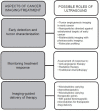Ultrasound for molecular imaging and therapy in cancer
- PMID: 23061039
- PMCID: PMC3466813
- DOI: 10.3978/j.issn.2223-4292.2012.06.06
Ultrasound for molecular imaging and therapy in cancer
Abstract
Over the past decade, molecularly-targeted contrast enhanced ultrasound (ultrasound molecular imaging) has attracted significant attention in preclinical research of cancer diagnostic and therapy. Potential applications for ultrasound molecular imaging run the gamut from early detection and characterization of malignancies to monitoring treatment responses and guiding therapies. There may also be a role for ultrasound contrast agents for improved delivery of chemotherapeutic drugs and gene therapies across biological barriers. Currently, a first Phase 0 clinical trial in patients with prostate cancer assesses toxicity and feasibility of ultrasound molecular imaging using contrast agents targeted at the angiogenic marker vascular endothelial growth factor receptor type 2 (VEGFR2). This mini-review highlights recent advances and potential applications of ultrasound molecular imaging and ultrasound-guided therapy in cancer.
Figures





References
Grants and funding
LinkOut - more resources
Full Text Sources
Other Literature Sources
Molecular Biology Databases
Miscellaneous
